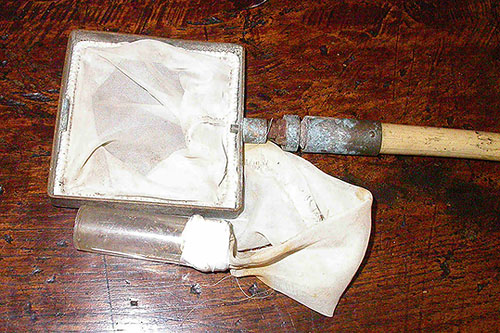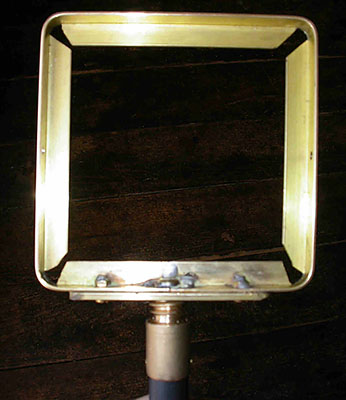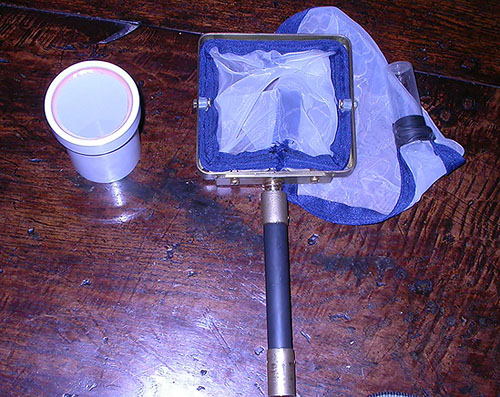
|
Simple pond
sampling equipment |
This article describes the fabrication of simple pond sampling equipment for those on a tight budget. The most important item is, of course, a net, but other easily made devices can also be helpful. We’ll describe some of these with details of construction so that anyone can make these or similar items. For the amateur, they perform quite adequately for sampling the biota. And they are much cheaper than professional kit.
Pond nets
I (HR) still have my first pond net – purchased from the wonderful Flatters & Garnett firm circa 1960 for £4 19s 6d. This was quite a lot of money, but I still use it regularly.
It measures 4 inches square, and is made entirely of brass – an important point.

Fig. 1
Brass has advantages and disadvantages for net frame construction. It does not corrode with use in freshwater or in the sea, and this is a most important feature. It is, however, not easy to work and not easy to join, though this can be done with practice.
Our new net is based loosely on the design of the old one- an angle brass frame, with the net itself built onto a brass rod which is retained in the flange of the frame. The net can easily be replaced by stitching another onto the rod, then reinstalling this subframe on the flange of the main frame. It is important not to make the net too large, as if you do, it will just be too hard to use and will push rather than filter water. 4-5 inches square is about right for most of us.
The first step was to obtain some angle brass of suitable size, from a non-ferrous metal stockholder on a nearby industrial estate. Initially I bought two lengths of different gauges, and ended up using the lighter of the two. 12mm x12 mm x2mm. 2mm is perfectly adequate, and the other piece, 3mm thick, proved hard to work.
You need to plan your frame carefully, and when you are sure of the dimensions, cut a length with a hacksaw. You then have to bend the brass to form a rectangular frame, with the join closest to where the handle will go. This means cutting wedges out of one flange at the bend points, and it is best to make the wedges generous, the more easily to bend the outer frame.
One of the problems with brass is that it work-hardens. If you hammer or bend it, it may suddenly fatigue and break. I tried heating, to anneal it, but found in the end that it was best to make a single controlled bend by hand using a six inch nail in a vise as a fulcrum. You should end up with a square frame with a join point in the centre of one side. Although brazing to join brass is possible, as is hard soldering, it requires skill and equipment. I chose to solder the ends in position, and then bolted some 3mm angle brass across the join with 4mm bolts, cut to size. Once in place, I soldered the threads to secure them. This gave a square frame with an external bolted reinforcement for the handle. The handle consists of a polypropylene drain rod with brass fittings. I drilled a 3.5mm hole in the top of the male fitting, then tapped an M4 thread in the hole (taps and dies can be bought quite cheaply for this), The handle was then fitted to the frame with an M4 brass pan-head bolt.

Fig. 2
The first step in making the net was to make a wire frame, again, out of brass rod. Brazing rods of 3mm diameter are ideal for this, and after careful marking can be bent to the internal dimensions of the frame. The two ends are not joined, so they can act as a ‘spring’ to hold the net in the frame, and when finished, the net itself is retained by two small bolts and a plastic spacer as seen in the photograph.

Fig. 3
The net material can be varied according to requirements, and indeed, nets of various grades can easily be fitted to the main frame.
The very best material is a nylon version of bolting silk – used in flour milling. However, any fine mesh will suffice, and there are plenty of polyester/nylon materials available. “Nitex ™” is the preferred material for professional grade nets, but is expensive for the amateur, and generally only available in large quantities. Meshes and bolting silks come in various mesh sizes, and the size chose is a matter of personal preference. 120-150 micron meshes are probably a good choice for general use. Sizes down to 5 micron are available, and while these will retain small phytoplankton, they will also retain everything larger and quickly get blocked. The very fine size meshes are also very expensive.
All meshes are fragile, and replacement is quite often necessary. This part of the project required Anna’s textile skills. In our net Anna sewed some polyester tape to the mesh itself to protect against wear on the frame. She stitched the net edges sandwiched between tape which had been folded on itself, with a space at the top to hold the wire frame. Forming an approximate cone, the final step is to make a hem at the apex of the cone, and attach a glass sample tube. Glass breaks, but plastic tubes quickly get scratched and become opaque. Self-amalgamating tape, from Maplins, is used, stretched to retain the bottle. Ordinary insulating tape works surprisingly well too. The bottle is emptied by everting the net.
Using the net
Pond nets are fragile, and are actually filters rather than nets. Avoid snagging the net on submerged objects, and keep away from the bottom mud. The recommended action is a slow, languid figure of eight track -–sufficiently fast to keep the net cone inflated but not so fast as to push water in front of the net. Beware of stirring up too much sediment which will just clog the net. The frame is designed so that the far edge can be used to scrape the surface of submerged posts for bryozoa, diatoms etc. Some users file the edge to make a sharper scraper. Decant the sample bottle periodically into a jar, and leave to stand for a while, when hydra and planarians may emerge. Use the net to sample under and through aquatic plants. The standard 120-130 micron mesh will capture quite small organisms, which ‘bounce’ down in and into the specimen tube.
It is very important that every sample obtained with a net should be carefully checked for frog, toad and newt tadpoles (the latter often have prominent gills) or adults. Also for larger insect larvae. Any found should immediately be returned to the pond. Amphibians increasingly are threatened, and do not survive in captivity."
Other sampling devices
Turkey basters are useful. Also they can easily be adapted to attach to a length of plastic tube gaffer taped to a fisherman’ telescopic pole. I use a Higginson syringe for this. The gadget allows samples of sediment and biofilms to be obtained without bending or falling in the water.

Fig. 4
Wash filters
These consist of about 10cm of plastic pipe (drainpipe) with a fine filter stretched across the end. Water is poured through the filter, then the contents are carefully backwashed with a wash bottle or sprayer into a small volume specimen tube for the microscope.
Very fine meshes (25 micron)are obtainable from tropical fish suppliers who use them in brine shrimp culture, and for filtering cultured rotifers. A web search for brine shrimp suppliers will provide many sources. Because of how they are used, wash filters are less prone to clogging than nets. The filtering does need to be gently, in view of the fragility of organisms in this size range. An example of a wash filter is shown next to the net.
Traps and scrubbers
Traps can be used in streams and lakes to attract and retain organisms. Unravelled polypropylene rope, suspended for a week or two, will often be colonised by a wide variety of organisms worthy of microscopical examination. Anything which provides lots of interstices and which will not rot can be used.
Scrubbers, the common green and yellow pan scrubber can be a surprisingly useful device for harvesting diatoms from rocks etc. A wiping action, then squeezing into a small sample bottle is the technique I prefer. Groynes and submerged logs are also good sources of material.
We hope that this will encourage readers to try these low-tech solutions. Professional equipment is nice, but can be rather expensive and although our simple gadgets are not really suitable for quantitative work, they will be quite good enough for the average pond enthusiast.
Comments to the authors, Hugo and Anna Baillie-Johnson, are welcomed.
Microscopy UK Front Page
Micscape Magazine
Article Library
Please report any Web problems or offer general comments to the Micscape Editor.
Micscape is the on-line monthly magazine of the Microscopy UK web site at Microscopy-UK.